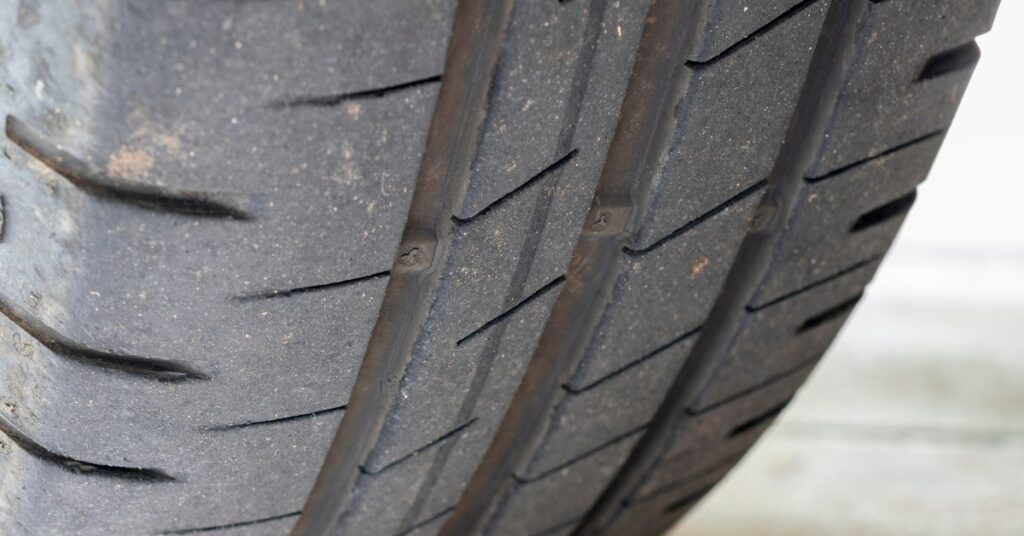
Table of Contents
A commonly overlooked aspect of car maintenance is recognizing and understanding uneven tire wear. Not only can it shorten the life of your tires, but it can also be a symptom of other underlying issues that may need immediate attention.
How Incorrect Tire Pressure Affects Tire Wear
Correct tire pressure is fundamental to preventing uneven tire wear and enhancing tire life.
Underinflation: Tires that lack the proper air pressure can’t maintain their ideal shape under the vehicle’s weight. This situation forces the tire’s sides to bear an excessive load, leading to abnormal wear along the tire’s edges. It can also result in poor gas mileage and handling, making driving inefficient and potentially unsafe.
Overinflation: Conversely, too much air pressure can cause the tire’s middle section to carry most of the vehicle’s weight, reducing the tire-to-road contact area. This results in accelerated and uneven wear in the central part of the tire. Overinflation can also make tires more susceptible to damage from potholes or debris on the road.
Refer to your vehicle’s user manual or the driver’s side door jamb placard for the manufacturer’s recommended tire pressure. Regularly check your tire pressure, ideally once a month and before long trips.
The Crucial Impact of Wheel Alignment
Wheel alignment, or tracking, involves adjusting the angles of the wheels so that they are perpendicular to the ground and parallel to each other. Misaligned wheels can lead to problems, including rapid and uneven tire wear, reduced fuel efficiency, and compromised handling. The three main alignment parameters – camber, toe, and caster – influence the tire’s contact with the road.
Camber refers to the tilt of the tire from vertical when viewed from the front. Excessive positive or negative camber can cause the tire to wear more on one side.
Toe alignment is the extent to which your tires turn inward or outward when viewed from above. Incorrect toe alignment can lead to a feathered wear pattern across the tire.
Caster is the angle of your steering axis when viewed from the side. While it doesn’t contribute to tire wear, a faulty caster angle can affect vehicle stability.
Routine alignment checks and adjustments can help prevent these issues.
The Role of Suspension Components in Tire Wear
The suspension system keeps tires in contact with the road and absorbs road shocks. Any worn or damaged suspension components can negatively impact tire contact, leading to uneven tire wear.
Shocks and struts play a crucial role in stabilizing your vehicle. When they start to wear out, you may notice cupping – a series of worn spots – on your tires due to the bouncing effect.
Bushings, made of rubber or polyurethane, cushion the vehicle’s moving parts. Cracked or worn bushings can cause excessive tire wear.
Regular suspension inspections and timely part replacements can help maintain your vehicle’s ride comfort and prevent uneven tire wear.
Balancing Act: The Impact of Unbalanced Tires
Balancing involves adjusting the weight of the tire and wheel assembly so that it travels evenly at high speeds. Unbalanced tires can cause vibrations, leading to uneven tire wear, strain on the suspension system, and a less comfortable ride. Tire balancing should be performed whenever a tire is mounted onto a wheel, such as when it’s repaired or replaced.
The Importance of Tire Rotation
Since each tire position on a vehicle carries a different weight, not rotating your tires can result in uneven wear. Following the pattern recommended in your vehicle’s user manual, regular tire rotation can promote even tire wear and extend tire life.
How Driving Habits and Vehicle Load Affect Tire Wear
Aggressive driving habits like fast acceleration, hard braking, and high-speed cornering can lead to accelerated and uneven tire wear. Moreover, carrying loads heavier than your vehicle’s recommended capacity or unevenly distributed weight can add extra stress to your tires.
Contact McCullough NAPA Auto Care To Schedule Tire Service
In conclusion, preventing uneven tire wear is a multifaceted process that includes maintaining correct tire pressure, ensuring wheel alignment, checking suspension components, balancing and rotating tires, and adopting good driving habits. Regular vehicle maintenance checks are critical to identifying and addressing issues before they lead to uneven tire wear.
If you notice signs of uneven tire wear, it’s best to consult a professional mechanic. At McCullough NAPA Auto Care, our experienced team can inspect your tires and provide expert advice to keep you safe. Contact us to get started.
FAQ About Uneven Tire Wear
Uneven tire wear can be fixed through a variety of ways. The most common include tire rotation, alignment checks and adjustments, and maintaining correct tire pressure. For more severe cases, it may be necessary to replace the worn tires or even some suspension components.
If only one tire is going bald, it could be due to improper alignment, suspension issues, or a damaged tire. This could also be a sign of an unbalanced wheel or the result of aggressive driving habits.
Yes, driving on unevenly worn tires can be dangerous. They can decrease the efficiency of your braking system and negatively affect the vehicle’s handling. This could lead to less control while driving and potentially result in a car accident.
Symptoms of uneven tire wear include noticeable loss of tire tread on one side more than the other, vehicle pulling to one side, vibrations in the steering wheel, and decreased fuel efficiency.
Yes, bad struts can indeed cause uneven tire wear. Worn or damaged struts can affect the vehicle’s alignment, leading to rapid and uneven tire wear. This is why it’s crucial to have your suspension system checked regularly.
It’s not recommended to drive with uneven tire wear for any length of time. While there’s no specific timeframe, the risks increase the longer you drive on worn tires. It’s always best to get uneven tire wear checked out and addressed as soon as possible to avoid further damage or potential safety risks.

